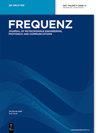高选择性双频带BPF的设计
IF 1
4区 工程技术
Q4 ENGINEERING, ELECTRICAL & ELECTRONIC
引用次数: 0
摘要
摘要本文基于三条并联耦合线设计了两个具有高选择性和可独立控制通带的双频带微带带通滤波器。本文提出的第一个BPF是通过使用一对折叠的F型谐振器(FFR)和传统的TPCL结构来实现的。通过调整每个FFR的上述参数,可以容易地控制两个通带的中心频率。同时,TPCL可以增强电源和负载之间的耦合,并引入多个传输零点(TZ),这有助于提高选择性。为了获得优异的选择性,第二个BPF是基于一种新型的TPCL设计的。新型TPCL在传统TPCL的基础上,由于传输路径加倍,进一步提高了选择性。为了实现小型化和增强耦合,对FFR进行了折叠。此外,生成四个传输零点(TZ)以提高两个通带的选择性。所制备的以2.45/3.5GHz为中心的BPF的测量结果与模拟结果吻合良好,验证了所提出的设计方法。本文章由计算机程序翻译,如有差异,请以英文原文为准。
Design of dual-band BPFs with high selectivity
Abstract In this article, two dual-band microstrip bandpass filters (BPFs) with high selectivity and independently controllable passbands are designed based on three parallel-coupled lines (TPCLs). The first BPF proposed in this paper is achieved by employing a pair of folded F-type resonators (FFRs) and conventional TPCL structure. By adjusting the above parameters of each FFR, the center frequencies of the two passbands can be controlled easily. In the meantime, TPCL can enhance the coupling between the source and load, and introduce multiple transmission zeros (TZs), which can conduce to a higher selectivity. To obtain superior selectivity, the second BPF is designed based on a novel TPCL. The novel TPCL is based on the traditional one, which further enhances selectivity since transmission paths are doubled. In order to achieve miniaturization and enhance coupling, FFRs are folded. In addition, four transmission zeros (TZs) are generated to improve the selectivity of the two passbands. The measured results of the fabricated BPFs centered at 2.45/3.5 GHz agree well with the simulated ones, which validates the proposed design method.
求助全文
通过发布文献求助,成功后即可免费获取论文全文。
去求助
来源期刊

Frequenz
工程技术-工程:电子与电气
CiteScore
2.40
自引率
18.20%
发文量
81
审稿时长
3 months
期刊介绍:
Frequenz is one of the leading scientific and technological journals covering all aspects of RF-, Microwave-, and THz-Engineering. It is a peer-reviewed, bi-monthly published journal.
Frequenz was first published in 1947 with a circulation of 7000 copies, focusing on telecommunications. Today, the major objective of Frequenz is to highlight current research activities and development efforts in RF-, Microwave-, and THz-Engineering throughout a wide frequency spectrum ranging from radio via microwave up to THz frequencies.
RF-, Microwave-, and THz-Engineering is a very active area of Research & Development as well as of Applications in a wide variety of fields. It has been the key to enabling technologies responsible for phenomenal growth of satellite broadcasting, wireless communications, satellite and terrestrial mobile communications and navigation, high-speed THz communication systems. It will open up new technologies in communications, radar, remote sensing and imaging, in identification and localization as well as in sensors, e.g. for wireless industrial process and environmental monitoring as well as for biomedical sensing.
 求助内容:
求助内容: 应助结果提醒方式:
应助结果提醒方式:


